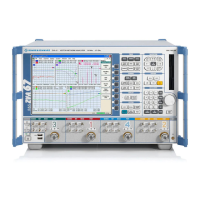System Overview
R&S
®
ZVA
83Getting Started 1145.1090.62 ─ 13
Examples:
●
a
1
Src Port 1 is the outgoing wave at test port 1. In a standard S-parameter mea-
surement, this wave is fed to the input port (port 1) of the DUT (forward measure-
ment).
●
b
1
Src Port 1 is the incoming wave at test port 1. In a standard S-parameter mea-
surement, this is the reflected wave at port 1 of the DUT (forward measurement).
3.3.2.10 Ratios
A ratio measurement provides the complex ratio of any combination of transmitted or
received wave amplitudes. Ratios complement the S-parameter measurements, where
only ratios of the form b
I
/a
j
(ratio of the incoming wave to the outgoing wave at the test
ports I and j of the DUT) are considered.
Examples for using ratios
A measurement of ratios is particularly suitable for the following test scenarios:
●
The test setup or some of its components (e.g. active components or non-recipro-
cal devices) do not allow a system error correction so that a complete S-parameter
measurement is not possible.
●
The test setup contains frequency-converting components so that the transmitted
and the received waves are at different frequencies.
●
A ratio of two arbitrary waves that is not an element of the S-matrix (e.g. a ratio of
the form a
I
/a
j
) is needed.
The notation for ratios includes the two waves with their directions and test port num-
bers. Additionally, the source port must be specified. In analogy to wave quantities, the
letter a indicates an outgoing wave, b an incoming wave.
Examples:
●
b
2
/a
1
Src Port 1 is the ratio of the outgoing wave b
2
at port 2 and the incident wave
a
1
at port 1; this corresponds to the S-parameter S
21
(forward transmission coeffi-
cient).
●
b
1
/a
1
Src Port 1 is the ratio of the wave quantities b
1
and a
1
, measured at PORT 1;
this corresponds to the S-parameter S
11
(input reflection coefficient).
3.3.2.11 Unbalance-Balance Conversion
Unbalance-balance conversion is the simulation of one or more unbalance-balance
transformers (baluns) integrated in the measurement circuit in order to convert the
DUT ports from an unbalanced state into a balanced state and virtually separate the
differential and common mode signals. The analyzer measures the unbalanced state
but converts the results and calculates mixed mode parameters, e.g. mixed mode S-
parameters. No physical transformer is needed.
Measured Quantities

